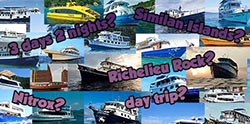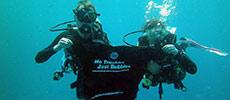
Here we try to answer common questions and answers about getting to and diving at the Similan Islands. However, if there's something not here, or you're still unclear, please contact us for a more personal or detailed answer.
- Can anyone dive in the Similan Islands, even if they have never dived before?
- What is the National Park Fee, and why is it not included?
- How deep can I dive?
- How many times can I dive per day?
- How do I get to the dive center or pier?
- Can my non-diving partner or children come along?
- How do I get to the Similan Islands?
- How do I get to Phuket?
- I haven’t dived for a long time what should I do?
- How do I book a diving trip?
- What happens if I book a diving trip, then have to cancel?
- How do I pay?
- Is equipment included?
- How deep is the water at The Similans Islands?
- What is so special about the Similan Islands and Richelieu Rock?
- I have lost my diving card. Can I still dive?
- What if I’m late?
- What about my bags?
- Can I rent a camera?
- Will there be a photographer or videographer on the trip?
- Can I do a day trip from Phuket?
- How about paying a tip for my liveaboard trip? Do I have to, and how much is a normal tip?
: Can anyone dive in the Similan Islands, even if they have never dived before?
A: No, not anymore. In almost all cases you need to be an already-certified diver before you join a Similan liveaboard or day trip. There are a few boats who can navigate the rules, but you need to arrive in Khao Lak 24 or 48 hours before your planned trip.Why do most Similan diving prices charge extra for equipment? Surely, you can’t dive without it, so it should be included in the price?
This is true, but most people who visit the Similan Islands to dive are already experienced and enthusiastic divers. Many of them have partial or complete sets of diving equipment of their own. To offer fair pricing in a competitive market, it makes sense for the dive centres to separate the cost of the trip and any equipment rental. In addition, most of them do not charge a great deal, even for complete sets.
: What is the National Park Fee, and why is it not included?
A: The fees for entering, and diving, at the National Parks are charged by the Thai government to pay for the upkeep of the marine park, especially the rangers to control tourist visitors and keep illegal fishing boats away. Like the equipment pricing, it is often separated to show competitive prices. Once one dive centre started, the others had to copy otherwise they would appear to be more expensive. Unlike the equipment rental, everyone has to pay. The price is lower for non-divers than it is for those who dive.
: How deep can I dive?
A: The Similan Islands and surrounding areas are home to many fantastic dive sites, most of which have lots of marine life right up to the surface. However, there are also times and places when diving deeper is necessary or more enjoyable. Open Water divers are certified to dive with a buddy and/or Divemaster guide to a maximum depth of 18m. Many dive sites in Thailand’s part of the Andaman Sea are thirty or more metres deep. It is advisable in all cases for those diving at The Similan Islands on a liveaboard cruise to consider an ‘Adventure Deep’ dive, which can be done on almost any liveaboard trip. This usually costs around 1,500THB and enables them to dive to 30m from that time on. On one or two of the trips we offer, this deep diving certification is compulsory. On the rest, it is just recommended.
: How many times can I dive per day?
A: Most liveaboard cruises allow divers to take part in up to four dives per day, including one at sunset or in the evening. For physiological reasons of safety, and because of the average depths, it is not possible for recreational divers to do more than this. The night dive is normally shorter in time and shallower than the day dives, which are up to 65 minutes long. On Similan day trips, the maximum number of dives is two. This is simply due to the logistics of travel time and surface intervals.
: How do I get to the dive center or pier?
A: Almost all of the boats we offer cruises on are moored at Tab Lamu (Thap Lamu) pier in Phang Nga. One or two sail from Phuket, but the nearest point of the mainland to the dive sites is at Tab Lamu pier. All of our dive center partners will transport guests from Khao Lak hotels and resorts to the pier for free and in time to board the boat. Some even offer a free pick up service from hotels and the airport in Phuket. This free pick up service normally starts in the south of Phuket in the mid-afternoon and passes the airport in the early evening, ready for 8-10pm departure from the pier. The journey from Khao Lak town to the pier is 14km, and there is rarely any traffic to affect the travelling time. From Phuket airport to Khao Lak takes about an hour, and is a distance of 72km. From Phuket Town or the hotel and resort areas such as Patong, it is purely dependent on the traffic, but journeys can take two hours in some cases. Private taxis in Phuket almost never use the meters and the average costs are 1,500THB from the airport and 2,000-2,500THB from Patong and Phuket Town. Public buses depart from Phuket Town every hour or so and pass the airport. This is a much cheaper option, but will obviously take considerably more time. For those joining a liveaboard cruise which sails in the evening, it is advisable to leave one’s hotel at lunchtime by taxi or mid-morning by bus. Depending on the boat and dive center it’s sometimes possible to leave the airport at any time up until 7pm, if travelling by taxi. Some boats, however insist on guests arriving in Khao Lak by 3pm for an evening departure. Day trips and some liveaboard trips, leave in the morning, so guests are strongly advised to spend the night before in Khao Lak, rather than Phuket.
: Can my non-diving partner or children come along?
A: In some cases, the answer is yes. Although the liveaboard boats are designed for divers, those divers spend more than twenty hours per day not diving, so appropriate facilities and activities are necessary. Most trips include one or more non diver. Discounts vary from one trip to another. Nearly every diving location, except for Richelieu Rock, has something for non-diving passengers to see and do. Please note that for safety and insurance reasons, very young children and babies are usually not able to join trips far out to sea. Please ask us in each case.
: How do I get to the Similan Islands?
A: The only way to reach the Similan Islands, the westernmost point of Thailand which is quite far out to sea, is by private boat. There are no public ferries, and certainly no airport. Speedboats and speed-catamarans can reach the Similan Islands from Tab Lamu or Khao Lak in a little under two hours in favourable conditions. Liveaboard diving boats usually sail overnight, with one or two leaving early in the morning.
: How do I get to Phuket?
A: Phuket has an international airport, which also accommodates flights from several locations in Thailand. It’s easy to get a bus there (from many locations) too, but not a train. The bus station and most of the resorts and hotels are in the south of Phuket, with the west coast being most popular. There are more luxurious resorts and beaches further north on the west coast. The airport is in the north very near the bridge to the mainland. Phuket Town, the island’s capital, is in the south east corner, as is Chalong Beach, which is where several dive centers and resorts are.
: I haven’t dived for a long time what should I do?
A: Most dive centers like to have divers on Similan liveaboard and day trip boats who have dived within the last twelve months. However, if you haven’t dived for more than a year, it’s no problem. Some of them are very strict and insist on the diver taking part in a ‘Scuba Review’ which is a refresher dive, practicing skills in the pool then in the sea. Some others are flexible and able to accept divers who haven’t dived within a year, as long as the diver has a decent amount of experience or the ‘more than a year’ period isn’t too long. Those who need a ‘scuba review’ can normally do it as part of their day trip or liveaboard cruise, although the pool session may inconvenience their travel plans.
: How do I book a diving trip?
A: This is the easy bit. All you need to do is click on the ‘book/enquire’ or ‘contact us’ links. We offer an excellent service and commitment-free unbiased advice. We’re usually able to instantly respond to questions 24 hours a day. The actual booking process varies depending on the dive center and how soon before the trip the booking is made. Most ask for a deposit to confirm the place, then the balance is either paid when you arrive or one month before the departure. It all depends on each boat's booking policy. Payments can be paid by credit card via PayPal, and now direct bank transfers are very popular, especially using Wise or Revolut. Different dive centers have their own cancellation policies, but most are designed to benefit everyone involved. See below for cancellations.
: What happens if I book a diving trip, then have to cancel?
A: Each dive center has their own policies for customers who cancel after paying a deposit, or in full. All of the dive centers which we deal with are ‘real people’ with hearts. Other than a ‘no show’ when customers just don’t turn up to board the boat, there is nearly always something that they and we can do to either refund in part, in full, or move the booking to another date or boat, or transfer to others’ names. More info here
: How do I pay?
A: There are normally two payments – the deposit to book and confirm, then the balance. Most of our customers are now paying by direct bank transfers in their preferred currency, such as Euro, USD and many others. We also use the simple, safe and trusted method of PayPal to pay the booking deposit, generally 20-30% of the trip price. However, there are those who are already in Thailand and just make a quick Thai bank transfer or deposit. The final balance is most commonly paid in cash direct to the dive center on the day of departure. Nearly all of them accept credit cards, but may charge 3%. Several of our trips involve the customers being driven directly to Tab Lamu Pier, where there are ATMs, but no credit card swipe machines. It’s good to be prepared in advance. ATMs in Thailand can be unreliable and foreign banks suspicious of card abuse abroad, especially in this part of the world. Have cash, or a plan B.
: Is equipment included?
A: Usually diving equipment is included in the price, but not always. To appear competitive and give a fair option to those who have their own gear, many of our diving center partners do not include the equipment in the cost. Of those who do, most offer a discount to customers who bring their own. A full set of diving equipment is typically a mask, fins, BCD, regs, and wetsuit. One or two centres also include diving computers, as well.
: How deep is the water at The Similans Islands?
A: Depths at the diving sites of the Similan Islands vary. Most recreational divers who visit the area reach maximum depths of 25-30m, but there are those who descend much further as well as those who enjoy a full hour at just 12m or less. At most of the dive sites there is plenty of colourful and healthy marine life from just 5m, with just the few more extreme sites having nothing to see for the top 10m. Just about all divers at the Similan Islands will enjoy themselves, regardless of the depth or their level and amount of previous experience.
: What is so special about the Similan Islands and Richelieu Rock?
A: Firstly, we mustn’t forget Koh Bon and Koh Tachai, either. This part of Thailand’s Andaman Sea can be separated into two parts, with some diving trips visiting both and others one or the other. The two parts are the Similan Islands, which comprises of twenty or so great dive sites, and ‘The Northern Sites’ (Koh Bon, Koh Tachai & Richelieu Rock). Being quite far out to sea, and in sub-tropical seas, the dive sites are very healthy. There’s lots of colourful and interesting marine life to see, and the water is very clear. Although effects of natural coral bleaching and the 2004 tsunami can still be seen in places, the whole area is pristine and unaffected by human activity. The underwater scenery is almost as special as the animals which call it home or come to feed. Large sharks and rays are most commonly seen at the northern sites, but can make an appearance anywhere and at any time.
: I have lost my diving card. Can I still dive?
A: Yes, and it’s quite common, but the dive centers just need to run divers’ details through the PADI or SSI system first. This takes just a few minutes, but it’s always best to get this sorted out between the booking date and arrival in Thailand.
: What if I’m late?
A: Please don’t be! There are two kinds of trips, being day trips and liveaboards. The day trip boats are on particularly tight schedules, as they need to sail two or more hours out to the dive sites, give everyone a mandatory surface interval between dives, and then get back to the pier before dark. They can’t and don’t wait for guests who come late, but they do offer free a pick up service from Khao Lak hotels. Most of the liveaboard trips sail in the evening, arriving during the night and the guests wake up and dive straight away. Boats with an evening departure have more room for flexibility due to late arrivals, but many guests will have already been hanging around for several hours after arriving on time. For the sake of consideration to these others, as well as the captain and crew, we implore our customers to make arrangements to be on time. Nearly all of them are on vacation, so there is no excuse for tardiness.
: What about my bags?
A: Some diving guests take their luggage on board, but there really is no need. The dive centres are usually more than happy to securely store them for free. Many items in a tourist’s suitcase or backpack aren’t used when out on a liveaboard cruise, so the bag will only get in the way and cause unnecessary handling.
: Can I rent a camera?
A: Some boats offer a camera or GoPro for rent, but not all. For sure, there will be another guest or dive guide on the trip who takes pictures or clips. Renting GoPros and underwater cameras is a tricky business, due to potential flooding or damage, and deposits are required. Also, if you do rent one, it's unlikely to be the newest model.
: Will there be a photographer or videographer on the trip?
A: In most cases, yes. There is no pressure at all to buy the pictures or videos, but a large number of our customers are impressed enough by the videos, pictures, and diving that they want to take a record of it home.
: Can I do a day trip from Phuket?
A: Not through us. Day trips leave early from a pier north of Khao Lak. Phuket’s main hotel zone is more than an hour away, and taxis aren’t cheap. However, it does happen and is very convenient for those who take part. Our only day trip operator does not accept Phuket-based guests, as they require them to ‘check in’ in person the day before the dive.
: How about paying a tip for my liveaboard trip? Do I have to, and how much is a normal tip?
A: Paying a tip is common, but it's not expected and there is no fixed or normal amount to pay. It should depend on your feelings and how happy you are with the service on the boat. More info about tipping here.









